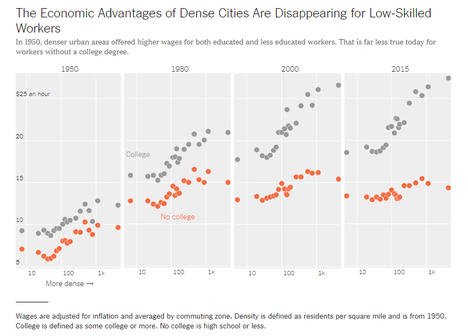(p. B1) “I believe tech can be a road to the middle class for large numbers of Americans,” said Mr. Hsu, a co-founder and the chief executive of Pursuit, a nonprofit social venture. “But there’s real skepticism about that among people who see the winners in technology as a small network of the privileged.”
He is using Pursuit, housed in a former zipper factory in Long Island City, the Queens neighborhood where Amazon had intended to locate, to try to prove those skeptics wrong.
The venture is a small yet innovative player in a growing number of nonprofits developing new models for work force training.
(p. B5) Their overarching goal is upward mobility for low-income Americans and the two-thirds of workers without four-year college degrees.
Pursuit, according to its donors and to work force experts, stands out for the size of the income gains of its graduates and its experiment with a kind of bond to finance growth. It is a program worth watching, they say, and beginning to attract attention nationally.
About 85 percent of Pursuit’s 300 graduates have landed well-paying tech jobs within a year. They work as software engineers both at major corporations like JPMorgan Chase and at start-ups like Oscar Health. They earn $85,000 a year on average, compared with $18,000 before the Pursuit program.
. . .
Max Rosado heard about the Pursuit program from a friend. Intrigued, he filled out an online form, and made it through a written test in math and logic, interviews and a weekend workshop with simple coding drills, joining the 10-month program in 2016.
At Pursuit, Mr. Rosado, who has a two-year community college degree in liberal arts, got an intensive immersion in programming languages, concepts and projects. But the curriculum also covered so-called soft skills like making presentations, working in teams and writing résumés and thank-you notes.
Today, Mr. Rosado, 30, is an engineer at GrubHub, the meal delivery service, working on its smartphone software. In his previous jobs, in back office and sales associate roles in stores, he earned $15,000 to $20,000 a year. He makes nearly $100,000 now, he said.
. . .
Pursuit screens applicants for many characteristics, but those mainly fall into two categories: problem-solving skills and perseverance. The program, Mr. Hsu said, looks for people who are hungry and determined, willing to put in the time and effort to become a software developer, but also able to adapt to new and unfamiliar environments.
For the full story, see:
Lohr, Steve. “A Way Out of Poverty and Into an $85,000 Tech Job.” The New York Times (Saturday, March 16, 2019): B1 & B5.
(Note: ellipses added.)
(Note: the online version of the story has the date March 15, 2019, and has the title “Income Before: $18,000. After: $85,000. Does Tiny Nonprofit Hold a Key to the Middle Class?”)

